How Can I Prevent Common Baseball Bat Injuries?
“An ounce of prevention is worth a pound of cure.” Benjamin Franklin’s words are very true in sports, especially in baseball. It’s key to know how to prevent injuries with baseball bats to keep players safe. I’ve seen how not using the right gear, bad techniques, and ignoring safety can cause injuries.
This article aims to give tips for young players, parents, and coaches to play safely. By following safety steps and knowing the dangers, we can cut down on injuries. For more on safety tips, check out how to prevent injuries caused by swinging bats. Let’s make baseball safer for everyone.
Key Takeaways
- Understanding the risks is the first step toward prevention.
- Practicing safe baseball bat handling techniques, like carrying the bat by the barrel, is vital.
- Incorporating warm-up routines and strength training aids in injury prevention.
- Awareness and communication with young players can help mitigate risks.
- Coaches play a critical role in developing a culture of safety.
Understanding the Risks of Baseball Bat Injuries
Playing baseball is thrilling, but it comes with injury risks. Even though it’s seen as a non-contact sport, accidents and overuse injuries are common. Knowing these risks helps me stay safe and play better.
Many common baseball injuries happen from bad technique or the wrong gear. Using a bat that doesn’t fit right or gloves that are too worn can cause pain and injuries. These issues can stop me from playing well. It’s key to handle the bat correctly to avoid these problems.
To avoid injuries in baseball, I pay attention to my gear, like my batting gloves. Good gloves give me a better grip, comfort, and reduce shock. This helps me play consistently. For tips on picking the best batting gloves, I can look at this guide on essential components.
Common Baseball Bat Injuries
Baseball is a thrilling sport, but it has its risks, especially with bat injuries. Knowing about these injuries helps me prevent them during games and training. This knowledge has been crucial in my baseball journey.
Rotator Cuff Tears
Rotator cuff injuries come from the repeated throwing in baseball. These injuries can really slow me down. To avoid them, I focus on strengthening my shoulder muscles and using the right throwing techniques.
Ulnar Collateral Ligament Injuries
Ulnar collateral ligament injuries mainly hit pitchers from the strain of throwing. I make sure to do exercises that help my elbow and arm. This helps lower my chances of getting these injuries.
Knee Injuries
Knee injuries often happen during base running and quick movements. Keeping my knees strong and stable is key to avoiding them. I work out to focus on knee stability.
Muscle Sprains and Strains
Muscle sprains and strains can happen anywhere, often from not warming up right or pushing too hard. I always warm up well before games and practices. Using my baseball bat correctly also helps prevent injuries. For tips on using my gear, I check out this resource.
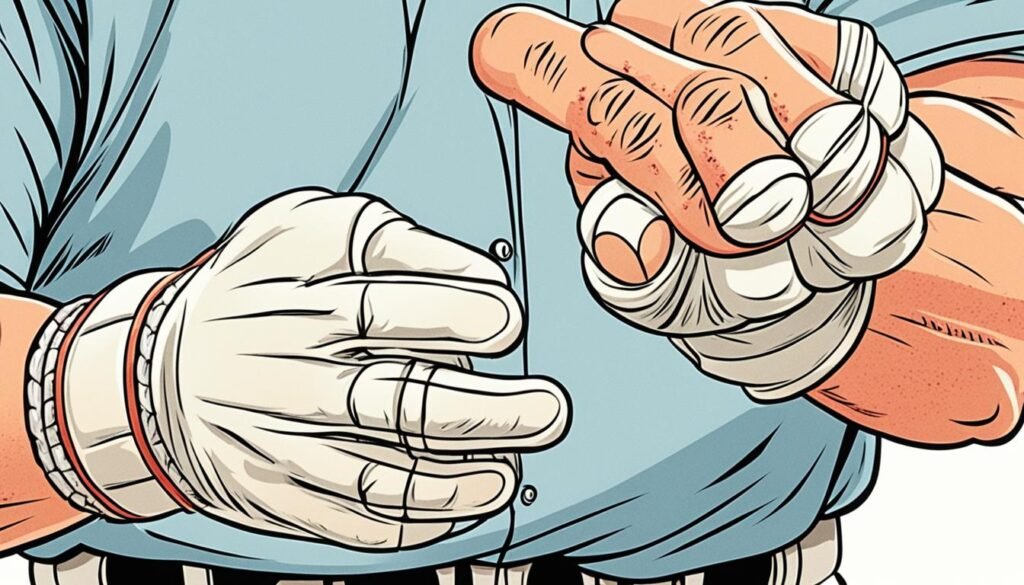
Proper Grip and Stance in Baseball
Getting the right grip and stance in baseball is key for better batting skills. I’ve found that a firm grip on the bat helps with control and power. It lets me focus on my swing and not worry about losing control.
My stance is also crucial. It sets me up for fast moves and quick changes during the game. The right stance keeps me balanced, making my swing smoother and more powerful. This way, I start my swing better and hit the ball harder.
Working on these basics cuts down on injury risks and boosts my game performance. For those looking to pick the best gear, check out this guide on choosing the right. Learning the right grip and stance is key to playing safely and effectively.
| Element | Description | Benefits |
|---|---|---|
| Proper Grip | Firm hold on the bat with fingers wrapped around the handle. | Increased control and swing stabilization. |
| Stance | Balanced, athletic position with feet shoulder-width apart. | Enhanced balance and readiness for dynamic movements. |
| Technique | Incorporating body alignment and follow-through actions. | Improved overall batting performance and reduced injury risk. |
Understanding grip and stance helps me improve my batting and play safer. Knowing how to handle my bat makes games more fun and successful.
Injury Prevention Strategies for Baseball Players
As a devoted player, I know it’s key to protect myself on the field for a great season. Using injury prevention strategies for baseball players can really cut down on injuries. Strength training and warm-up routines are two big ways to help.
Incorporating Strength Training
Strength training isn’t just about getting bigger. It’s about making muscles that support my joints. This gets my body ready for baseball’s demands. Focusing on muscles like my legs, core, and shoulders helps prevent injuries.
- Incorporate exercises like squats and lunges to strengthen the legs.
- Use planks and bridges for core stabilization.
- Focus on shoulder exercises such as rows and rotator cuff movements.
Effective Warm-Up Routines
Warm-ups are key to getting my body ready for the game. They increase blood flow to my muscles and get them ready for action. Spending at least 15 minutes on a dynamic warm-up helps me perform better and stay injury-free.
- Start with light jogging to elevate heart rate.
- Incorporate dynamic stretches, like arm circles and leg swings.
- Perform sport-specific movements to activate essential muscle groups.
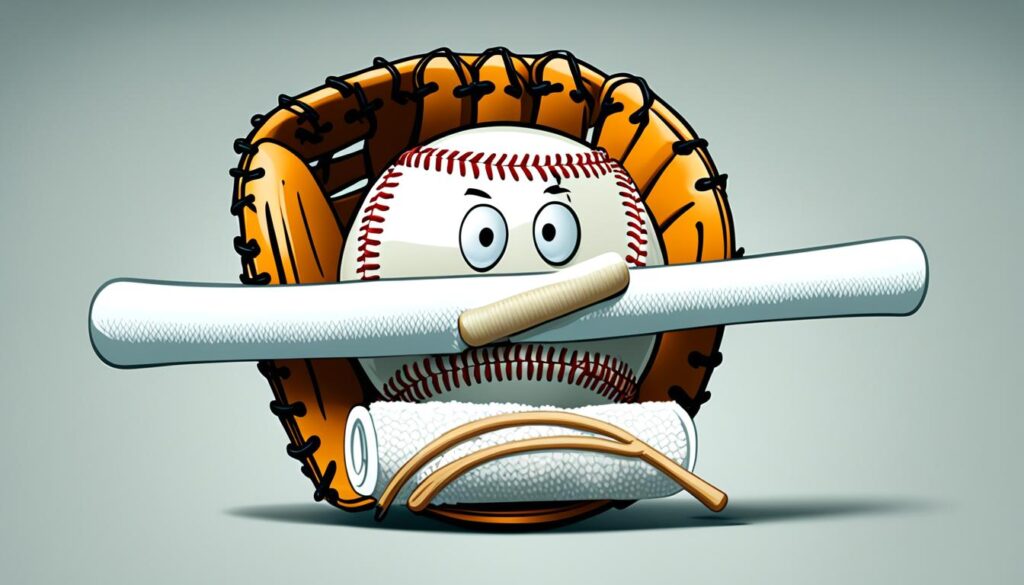
Baseball Bat Safety Tips
When I step onto the baseball field, safety is my main concern. I follow baseball bat safety tips to lower the risks. These tips are crucial for preventing injuries during practice or games.
Here are key points I always remember:
- Always store bats in designated areas to avoid tripping hazards.
- Inspect equipment regularly for wear and damage.
- Utilize appropriate bat sizes and weights for players, especially youth.
Knowing how to handle a bat safely helps everyone stay safe. In practice, I remind everyone to stay alert on the field. This is key for preventing baseball injuries.
By sharing these tips, we create a safe and careful culture. This way, we put the safety of all players first.
| Safety Tip | Description |
|---|---|
| Proper Storage | Keep bats in a designated space to prevent accidents. |
| Regular Inspections | Check for any damage or signs of wear before use. |
| Size and Weight | Choose bats that are appropriate for the player’s age and size. |
| Awareness | Encourage players to be vigilant about their surroundings. |
By following these baseball bat safety tips, we show our dedication to safe play. This makes the game more enjoyable and safer for everyone.
Safe Baseball Bat Handling Techniques
In my journey to become a better player, I learned how important safe baseball bat handling is. These skills keep us all safe and make the game more fun. By following a few simple practices, we can greatly lower the chance of getting hurt by a bat.
Carrying the Bat by the Barrel
Carrying bats safely by the barrel is key. This way, the handle points down, preventing accidental swings that could hurt others. It’s a simple rule that makes everyone feel safer during games and practices.
When to Swing the Bat
Knowing when to swing the bat is also crucial. I suggest swinging only in safe areas, with adults watching. This keeps the playing area safe and helps prevent injuries. Teaching my teammates about these rules helps us all play safely and respectfully.

Remember, safe baseball bat handling is everyone’s job. By working together, we can make the game safer for everyone.
Developing Safe Bat Swing Mechanics
In baseball, focusing on bat swing mechanics boosts my performance and safety. Learning to align my body and time my swing helps reduce stress and improves my hits. Proper mechanics give me better control over the bat and lower injury risks.
Practicing swing safety techniques in baseball is key. Doing drills to improve my swing mechanics makes a big difference. It’s about focusing on every detail, from my grip to my stance. Each part is important for good performance and staying injury-free.
- Correct grip posture for better control
- Optimal stance to enhance balance
- Timely execution of swings to avoid overexertion
- Regular feedback from coaches or training partners
By using these principles in my training, I can boost my batting skills and stay safe. As I develop these habits, I’m setting up for a successful and injury-free baseball career.
Hitting Drills for Injury Prevention
Doing specific hitting drills helps improve my technique and lowers injury risks. It’s key to know how the right tools can help my training. By focusing on drills for injury prevention, I make sure my practice is both effective and safe.
Using Proper Equipment
Choosing the right gear for baseball is crucial for players aiming to get better. The right bat and protective gear match my size and strength, making a big difference. A bat that fits well lets me swing without harming my body. Protective gear keeps me safe during practice.
Practice with Supervision
Having coaches watch over my practice is key to following safety rules. They spot wrong moves and fix them right away. This quick feedback boosts my skills and cuts injury risks. A well-organized practice space is where I learn and stay safe, helping me improve as a player.

Prevent Common Baseball Bat Injuries
To prevent common baseball bat injuries, I use several proactive methods. It’s crucial to know the risks and stay alert during games. This includes being aware of the game’s dynamics and keeping the playing area safe.
Effective baseball practices are key for me. I start with proper warm-ups, strength training, and the right grip and stance. These steps help reduce the risks of swinging a bat.
Preventive training boosts my performance and keeps me safe. I tell all players to focus on these methods, no matter their skill level. Getting medical help quickly for injuries helps in a speedy recovery, ensuring a safe return to the game.
Maintaining Awareness on the Field
Playing baseball is exciting, but it requires focus and responsibility. I know that staying alert on the field keeps me and others safe. This focus helps players play safely without worrying about getting hurt.
Educating Young Players
I work hard to teach young players about injuries from not paying attention. It’s crucial for them to know how to handle bats carefully. Learning about safety was key for me, through direct teaching and watching experienced players and coaches.
Here are some key points to understand safety better:
- Knowing the dangers, like players swinging without looking.
- Having regular talks about safe play in training.
- Learning from research on preventing injuries, including the latest studies here.
By taking part in these educational efforts, we make the game safer and more fun. Being responsible helps us enjoy the game more and lowers injury risks.
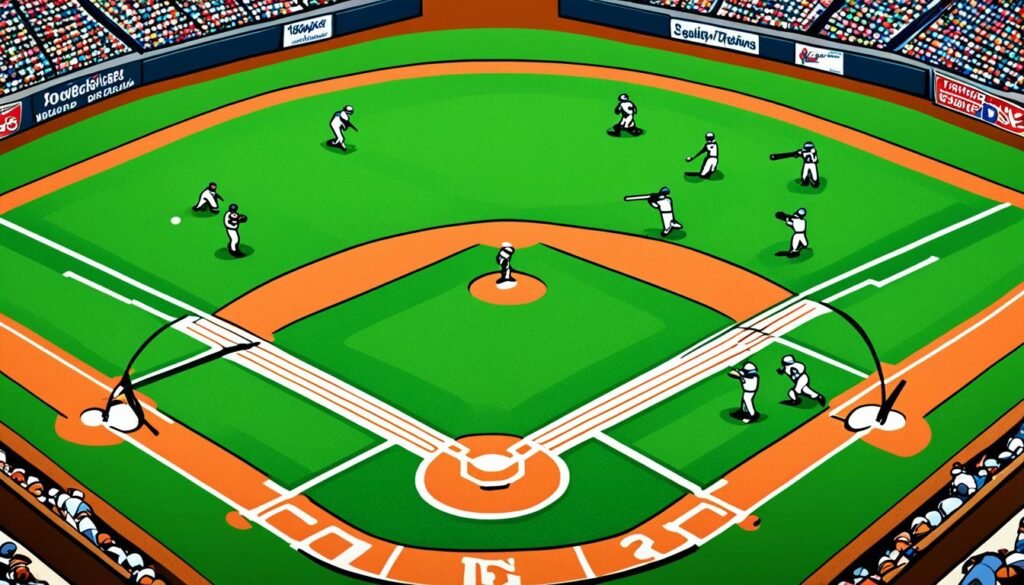
Communicating Injury Risks
Talking openly about player communication and injury risks makes baseball safer for everyone. When I talk with my teammates, coaches, and parents, we share concerns about possible injuries. This helps us all be more aware of injuries in baseball.
Regular talks help us see why it’s key to share injury risks. These chats build a supportive team and make players watch out for their safety and others’. Talking openly helps us spot and fix risks early, preventing serious injuries.
Here are some ways to improve how we talk:
- Encouraging team meetings to discuss safety protocols.
- Implementing injury check-ins before and after games.
- Utilizing visual aids, like charts or videos, to illustrate common injury risks.
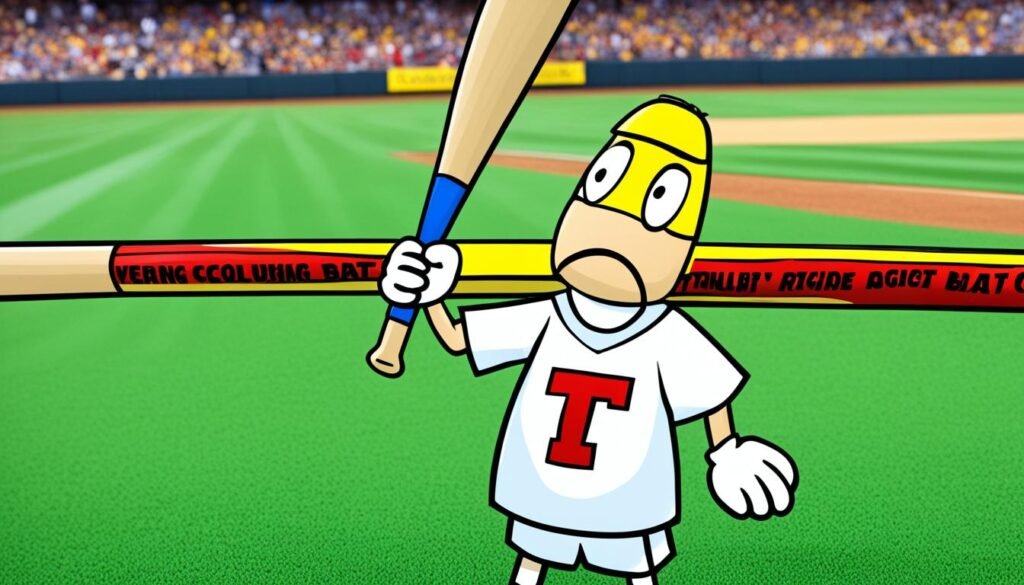
Putting a focus on awareness of injuries in baseball through clear talks helps us all. We work together to lower injury risks and make playing safer for everyone.
| Communication Strategies | Benefits |
|---|---|
| Team Meetings | Fosters a culture of safety and awareness |
| Injury Check-Ins | Identifies potential concerns early |
| Visual Aids | Enhances understanding of risks and prevention |
Maintaining Healthy Play Environment
Creating a nurturing atmosphere for players is key to their success and safety. I believe a healthy play environment is vital for injury prevention and fun. By creating a supportive setting, players can excel both on and off the field.
Understanding Game Dynamics
Knowing how baseball works helps reduce injury risks. It’s important to watch how players move, where they stand during plays, and how they do drills. Good team communication makes sure everyone knows what to do and where they are.
Putting a player safety approach first is crucial. This means talking often about staying hydrated, eating right, and resting. When players feel supported, they make better choices, which lowers injury risks.
| Game Dynamics Aspect | Description | Benefits |
|---|---|---|
| Positioning | Ensuring players are in the right spots based on the play. | Reduces risk of collisions and injuries. |
| Drill Execution | Conducting drills that emphasize safe movements and techniques. | Builds confidence and reduces overuse injuries. |
| Team Communication | Encouraging open dialogue about safety concerns and strategies. | Creates a safer environment for all participants. |

Minimizing Risks of Baseball Bat Injuries
Thinking about baseball bat injuries shows how important it is to use good strategies. Using injury reduction techniques helps keep players safe. It’s key to pick the right equipment, like the right bat size and weight, to lower injury risks.
Playing safely starts with good techniques. Players should know how to swing and position themselves to avoid getting hurt. Regular practice helps improve these skills and keeps players on their toes.
Staying active with strength training is also crucial. It makes muscles stronger against injuries. I’ve found that training not only boosts performance but also supports baseball safety practices by getting the body ready for the game.
Warming up before games is essential. A good warm-up gets blood flowing to muscles, making them flexible and less likely to get hurt. I often look up expert advice on how to warm up right.
Being alert during games helps players react to surprises. Being aware can prevent accidents, especially in quick moments. By focusing on teamwork and communication, we can make safety our top priority.

Putting these strategies together creates a solid plan for avoiding injuries. Staying consistent and knowing the risks helps ensure success and safety in baseball. For more tips on preventing injuries, check out resources on baseball safety practices and why choosing the right bat matters, which you can find here.
Creating a safe culture through education and awareness encourages everyone to focus on safety. Supporting each other as players, coaches, and parents helps make a safe space for everyone to enjoy the game.
Incorporating Safety Precautions for Baseball Bat Use
As a passionate player, I know how vital it is to use safety precautions with baseball bats. Bat safety measures keep me and others safe on the field. I always wear the right protective gear when using my bat.
Starting with safe habits means learning how to handle the bat right. I carry my bat by the barrel to avoid hitting others. Staying alert during practice helps prevent injuries in my team.
Following safety rules lowers the chance of getting hurt during games. I stick to safe swinging methods and know when to swing. I also look for ways to learn more about safety, like checking out safety guidelines.

| Safety Measure | Description | Benefits |
|---|---|---|
| Proper Protective Gear | Wearing helmets and padding during play. | Reduces risk of serious head injuries and other external injuries. |
| Safe Bat Handling | Carrying the bat correctly and being aware of surroundings. | Prevents accidental injuries and promotes safe gameplay. |
| Training Sessions | Regularly conducting safety training and drills. | Enhances knowledge and preparedness among players. |
Adding these safety steps to my routine encourages a safe culture among my teammates. Skill and safety go together. This focus on safety not only keeps me safe but also motivates my teammates to do the same.
Promoting Injury Prevention Practices in Youth Baseball
As a coach, I know I play a big part in keeping young athletes safe in baseball. They need a safe place to grow and play. By teaching safety first, I help make sure they stay healthy and happy.
Effective Coaching Strategies
Using a few smart strategies can really help prevent injuries. Here are some ways:
- Teaching the right techniques and how to use equipment safely
- Starting with a good warm-up to get players ready
- Working on strength and conditioning to make players stronger
I’m proud to teach my team about safety. When players know how important it is, they take better care of themselves. Talking about safety helps everyone feel like they’re all in this together.
Using technology can also make training better. Tools that check on how players perform can give them feedback right away. I often use bat sensors to help improve their swings, which makes the game safer.
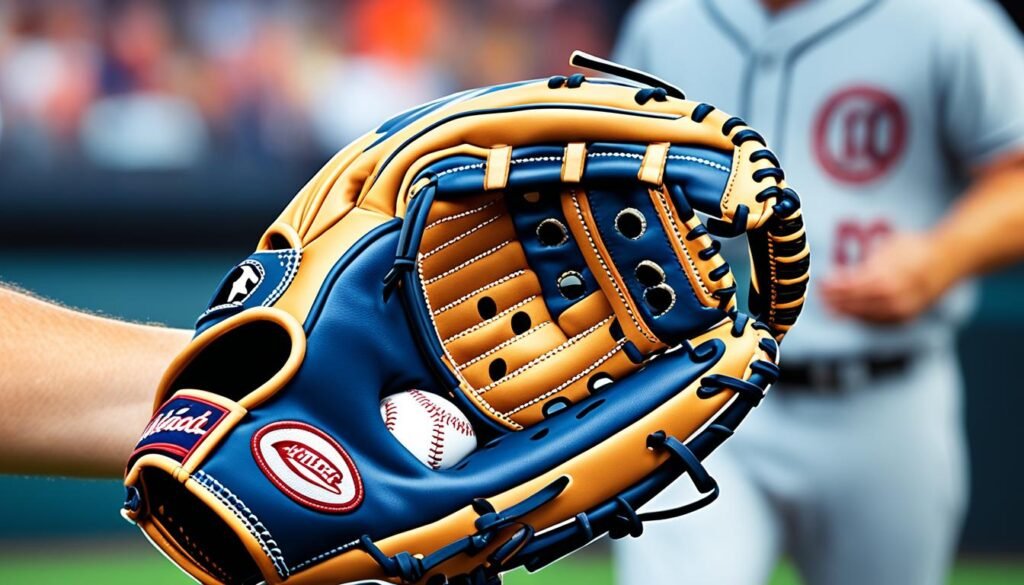
Putting a focus on preventing injuries does more than keep players healthy. It also helps them play better. By focusing on safety, we help young athletes grow and have a great time playing. I think we can make a safe and supportive place for all players to shine.
Conclusion
Reflecting on preventing baseball injuries shows us that these strategies are key for a safer game. Understanding the risks of using baseball bats and the importance of proper techniques is crucial. Each point highlights the need for a strong commitment to safety in baseball.
Effective warm-ups, strengthening exercises, and staying alert on the field are vital for player safety. These steps help reduce injuries. By focusing on education and creating a safe culture, we make the game better for everyone.
Baseball is about joy and friendship. By following the advice in this article, players of all ages and skills can enjoy the game safely. Let’s work together to make our fields safer.
FAQ
What are some common baseball bat injuries I should be aware of?
How can I improve my grip and stance to prevent injuries?
What are effective strategies for injury prevention in baseball?
What safety precautions should I take while handling baseball bats?
How can I develop safe bat swing mechanics?
What hitting drills can help in preventing injuries?
Why is awareness on the field important?
How can I communicate injury risks with my team?
What role does coaching play in promoting player safety?
Source Links
- https://www.orthohc.com/news/batter-up-common-baseball-injuries-and-how-to-prevent-them
- http://www.baseballpositive.com/blog-page-set-up/2020/9/30/how-to-prevent-injuries-caused-by-swinging-bats-simple-carry-the-bat-like-the-pros-z4z9k
- https://www.linkedin.com/pulse/home-run-health-7-ways-prevent-common-baseball-61e7c






1 COMMENTS